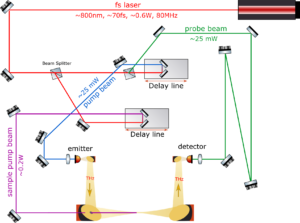Electromagnetic radiation in the terahertz frequency range (0.1 THz – 4 THz) has many important applications in the areas of spectroscopy, detection, and security. The group dispose of a Terahertz-Time Domain Spectroscopy (THz-TDS) System. It offers a frequency window between 0.2 and 3THz at room temperature with unique possibilities to characterise materials. Few-cycle THz pulses are generated by exciting an electrically biased photoconductive dipole with an ultrafast laser pulse (<100 fs). The resulting photo-generated current responds on a picosecond timescale and leads to THz electromagnetic pulse radiation. High-resistivity Si hyper-hemispherical lenses are used to improve the coupling efficiency of the THz radiation generated in the GaAs substrate of the photo-conducting dipoles into the free space. Additionally, off-axis parabolic mirrors are used to focus THz radiation on the sample. The system is shown in the photo.Photoconductor antenna, illuminated by ultra-short laser pulses, is used for THz emission and detection.

THz-TDS system
For the measurement of the electrical transport dynamics in semiconductors, nanocrystals, and other materials on the picoseconds time scale, optical pump – THz probe technique can be used. THz radiation emitter and detector for the measurements are dipole antennae on a LTG GaAs layer and are activated using two beams from the femtosecond laser. A third beam of Ti:sapphire laser is used for the photo-excitation of the samples. Excitation levels up to 2 µJ/cm2 can be achieved using a metallic aperture with the diameter of 300 µm. Both – optical pump and THz probe beams overlap at this aperture. The dependence of the THz transient signal at its maximum amplitude is measured at different delays of the optical pump pulse. Temporal resolution of this experiment is determined by the response of the detector measuring THz transients and is approximately equal to 1-1.5 ps. The maximum temporal range of the experimental setup at the USAL is 600 ps (limited by the optical delay line length).

